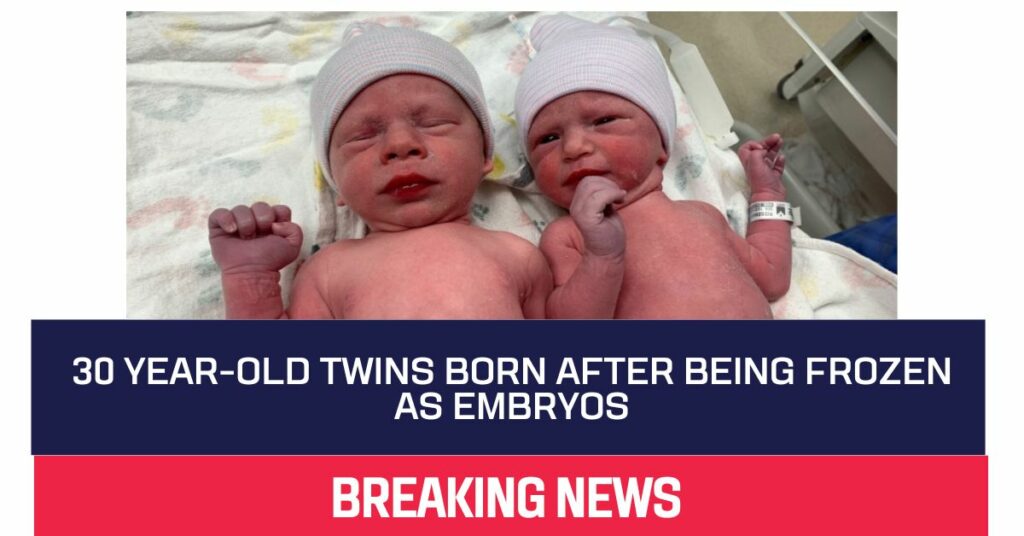According to the National Embryo Donation Center, twins Lydia and Timothy Ridgway, born on October 31, 2022, hold the record for the longest-frozen embryos to be taken alive. They were frozen for a total of 122 days.
Do you remember what you were doing in April of 1992? Or even during the entirety of this year? Because this incredible tale starts right there and there with the freezing of embryos.
According to the National Embryo Donation Center, the twins Lydia and Timothy Ridgway, born on October 31, 2022, hold the record for the longest-preserved embryos ever born alive. Their embryos had been frozen for a total of 365 days. Molly Gibson, born in 2020 from an embryo frozen for over 27 years, held the previous record for the longest time between conception and birth.
“I was five years old when God gave life to Lydia and Timothy, and he’s been preserving that life ever since,” said Philip Ridgway, the twins’ father. “There’s something mind-blowing about it,” added Philip Ridgway, the twins’ grandfather.
Even though they are our youngest children, we often refer to them as our oldest children.” A natural birth occurred for each of Philip and his wife’s subsequent four children, who are now 8, 6, 3, and almost two years old respectively.
More News:
- In The Us Capitol Riot Case, A Woman From Pennsylvania Was Found Guilty
- Republican David Valadao Represents California’s 22nd Congressional District
For nearly three decades, the embryos sat in storage in tiny straws preserved in liquid nitrogen at nearly -200 degrees celsius. The embryos were kept at a west coast fertility lab until 2007, when the couple who created them donated them to the National Embryo Donation Center in Knoxville, Tennessee, hoping another couple could use them.
“We never had a specific number of children we wanted in mind,” Philip said, “we always thought we would have as many as God wanted to give us, and…when we heard about embryo adoption, we thought it was something we would like to do.”
How Do Embryos Get Frozen?
People with artificial insemination (IVF), also known as “test-tube baby” procedures, may have an excess number of embryos. Additional embryos have the potential to be frozen for use at a later time, donated for the purpose of research or the advancement of reproductive medicine science, or given to people who have expressed an interest in starting a family.
“We weren’t looking to get the embryos that had been frozen the longest in the world,” said Philip, “we just wanted the ones that had waited for the longest.” When the Ridgways were seeking donors, they queried the donation centre about a category called “special consideration.” This meant that it was difficult to locate homes for these embryos for whatever reason may have been the case.
“We went into it with the mindset that we could put our faith in God to accomplish whatever He had planned and that their ages wouldn’t matter in any way. It was simply a matter of finding out whether or not it was in the designs of God, “Rachel remarked.
The length of time the embryos were stored in the freezer is not included in the donor database; however, the donor’s attributes are listed. These characteristics include the donor’s ethnicity, age, height, weight, genetic and health history, education, occupation, and favourite movies and music.
The couple assumed that those individuals listed with the earliest donor number had been at the centre for the most extended period, and they focused their selection on those individuals’ profiles to reduce their options. They didn’t find out how long their embryos had been frozen until they discovered they were pregnant.
On February 28, 2022, the embryos were allowed to thaw out. Two of the items that were defrosted out of a total of five were not helpful. Compared to the reality that there is approximately an 80 per cent survival probability following the thawing of frozen embryos, this is not a terrible number.
More News:
- First Recreational Marijuana Licenses Approved In New York
- A Trump Supporter Threatened An Election Official In Arizona Kari Lake Continues To Fight
Rachel stated that she recalled the doctor showing her a photo of the three babies and advising her to utilize only two because “many fetuses can cause pregnancy complications,” which the doctor had told her. Rachel only used two embryos. However, she stated that there was no question in her mind that all three would be utilized. She distinctly remembers crying and stating at the time, “You just showed me a photo of my three children, and I appreciate that. I can’t live without any of them.”
After being frozen for 29 years and ten months, Rachel’s three embryos were finally implanted into her uterus on March 2. However, only two of the transfers successfully resulted in a live birth.
According to the findings of various studies, the fertilization of a frozen embryo only results in birth between 25 and 40 per cent of the time. According to several experts, the age of the fetus should not have any bearing on the child’s health. The age of the woman who donated the egg that was used to create the embryo is far more essential; for example, “if the patient was 25 years old, then yes, it is possible that her embryos would survive.”
I hope you like our article. If this is the case, we would appreciate it if you would share your insightful ideas in the comments section. You can get even more of these updates by adding Journalistpr.com. to your list of bookmarks.

